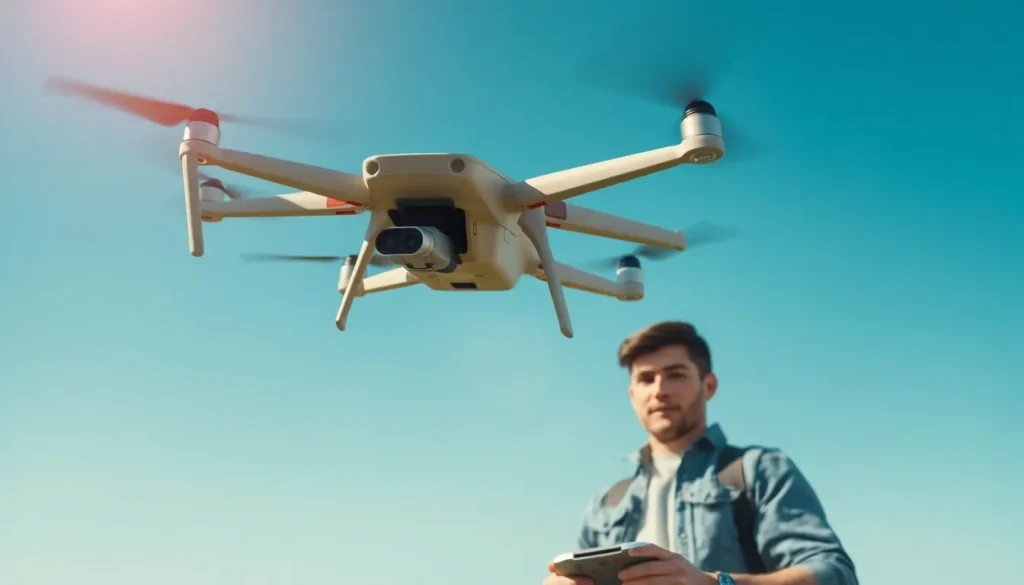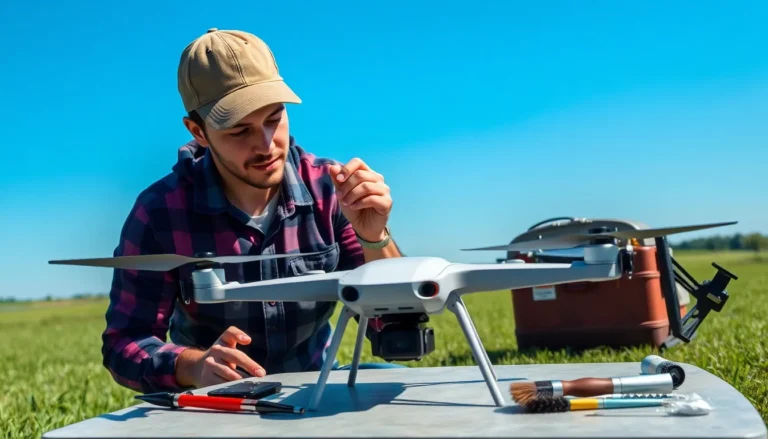In the fast-paced world of drone technology, keeping your flying companion updated is as crucial as charging its battery. Just like your favorite smartphone, drones thrive on software updates that enhance performance and unlock new features. Imagine soaring through the skies with a drone that’s not just flying but dancing—thanks to the latest firmware tweaks!
But let’s face it: updating drone software can feel like watching paint dry. Yet, those updates are the secret sauce behind smoother flights, better navigation, and even safety enhancements. So, buckle up and prepare to elevate your drone experience. It’s time to dive into the world of drone software updates and discover why staying current is a no-brainer for any serious pilot. After all, who wouldn’t want their drone to be the coolest kid in the sky?
Table of Contents
ToggleOverview of Drone Software Updates
Maintaining current drone software is critical for optimal performance. Updates often include performance enhancements that can significantly improve flight stability and battery efficiency. New features may also be introduced, expanding a drone’s capabilities and versatility. Safety upgrades are essential, as they address identified vulnerabilities and ensure adherence to the latest regulations.
Data indicates that frequent updates contribute to better navigation systems. Accurate GPS integration can reduce the risk of accidents and improve mission success rates. Each update provides an opportunity for pilots to benefit from the latest technology advancements. Embracing these updates helps maintain a competitive edge in the market.
In addition, many manufacturers release updates tailored for specific models, ensuring that enhancements align with particular performance needs. It’s important for pilots to regularly check for available updates and install them promptly. Following the manufacturer’s guidelines during the update process minimizes risks associated with potential disruptions.
Drone operators can easily compare old and new functionalities to assess improvements. Keeping software current not only increases efficiency but also promotes longer drone lifespans. Frequent updates represent an investment in the reliability and safety of drone operations.
Awareness of emerging trends in drone technology also drives the need for software updates. Pilots who remain engaged with advancements benefit from improved user interfaces and operational features. Taking the time to stay informed and updated pays off in enhanced flying experiences and safer operations.
Importance of Regular Updates

Regular software updates for drones play a vital role in maximizing functionality and safety. Keeping up with the latest updates ensures that pilots benefit from the most advanced features and improvements available.
Enhancing Performance
Software updates enhance drone performance through various means. Updates may introduce optimized algorithms that improve flight stability and responsiveness. Enhanced battery efficiency often stems from these updates, resulting in extended flight times. Users notice significant improvements in navigation systems as updates refine GPS accuracy. Not only do these enhancements boost operational efficiency, they contribute to maintaining competitive advantages in the market. Frequent updates provide users with improved user experiences and open up opportunities for new functionalities that elevate overall drone capabilities.
Improving Safety Features
Safety features receive significant upgrades during software updates. Updates often address vulnerabilities identified through user feedback and ongoing research. Manufacturers prioritize safety compliance, ensuring drones meet the latest regulations. Enhanced obstacle detection systems often emerge from regular updates, minimizing collision risks. Improved navigation aids, such as updated geofencing capabilities, further protect against unauthorized flights. Regularly implementing these updates safeguards both the operator and the public, ultimately leading to safer aerial operations in diverse environments.
Types of Drone Software Updates
Drone software updates fall into distinct categories, each serving a specific function. Understanding these types helps pilots maintain optimal performance.
Firmware Updates
Firmware updates enhance a drone’s core functionality. These updates provide crucial improvements to control software embedded directly in the drone’s hardware. Pilots benefit from enhancements that boost flight stability and improve battery management. Regular firmware updates also address critical security vulnerabilities, ensuring compliance with the latest regulations. Most drone manufacturers issue firmware updates regularly, highlighting the importance of keeping hardware current. Ignoring these updates could lead to performance issues or reduced flight capabilities.
Application Updates
Application updates play a key role in refining user interface and features. These updates often deliver new functionalities that enhance piloting experiences and improve operational efficiency. For instance, updates may include optimized flight planning tools or enhanced mapping capabilities. Regular application updates also ensure compatibility with the latest mobile operating systems, leading to smoother interactions. Therefore, pilots should frequently check for these updates to leverage improvements and new features effectively. Ensuring that the application remains current contributes significantly to achieving better navigation and mission outcomes.
How to Update Drone Software
Updating drone software is vital for optimal performance and safety. This process can typically occur through manual uploads or automated methods, depending on user preferences.
Manual Update Process
To manually update drone software, users should first visit the manufacturer’s website. Manufacturers often provide specific update files tailored for each drone model. After downloading the correct file, pilots need to connect the drone to their computer using a USB cable. Following this, they should follow the step-by-step instructions provided in the update documentation. Confirming the current software version before installation helps prevent any compatibility issues. Installing updates can take several minutes, so ensuring a stable power source during this process is crucial. After the update finishes, restarting the drone allows for the new software settings to take effect.
Automatic Update Options
Automatic updates streamline the software update process, ensuring users remain informed. Many drone manufacturers incorporate this feature within their corresponding mobile applications. Users simply enable notifications for updates, allowing the app to check for new software versions. Whenever a new update becomes available, the app prompts users to initiate the installation. This feature eliminates the need for manual checks, providing added convenience for busy drone pilots. While connected to Wi-Fi, the process usually updates the drone with the latest enhancements seamlessly. Ensuring the drone’s battery is adequately charged also contributes to uninterrupted updates.
Staying current with drone software updates is crucial for every pilot. Regular updates not only enhance performance but also ensure safety and compliance with regulations. By embracing these updates, operators can unlock new features and improve their drones’ overall functionality.
The process of updating is straightforward, whether done manually or automatically, and it significantly contributes to a better flying experience. As technology continues to evolve, keeping up with software advancements will help pilots maintain a competitive edge in the skies. Prioritizing updates ultimately leads to safer operations and longer-lasting drones.










